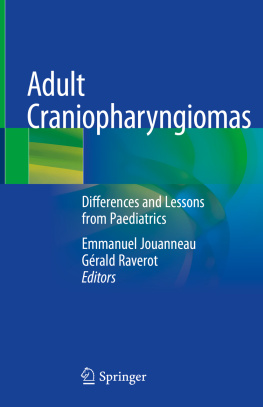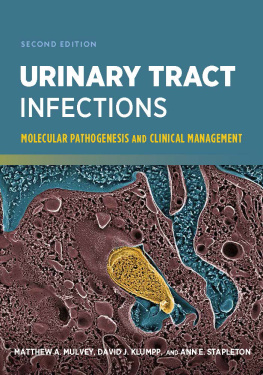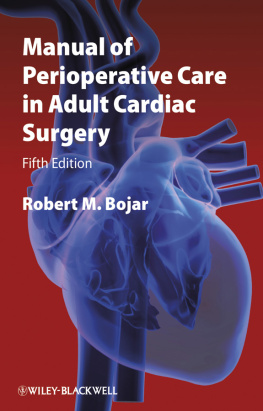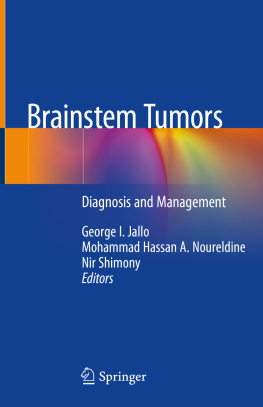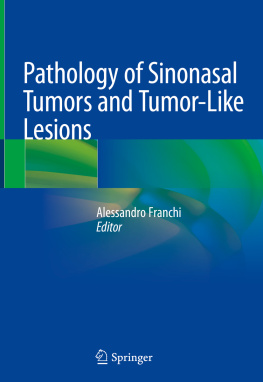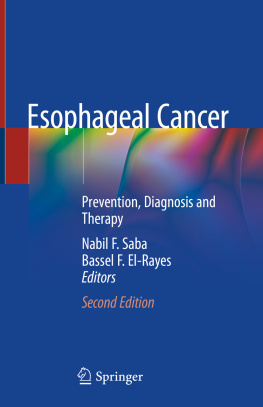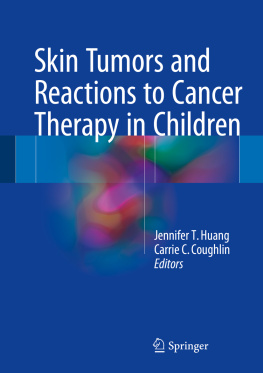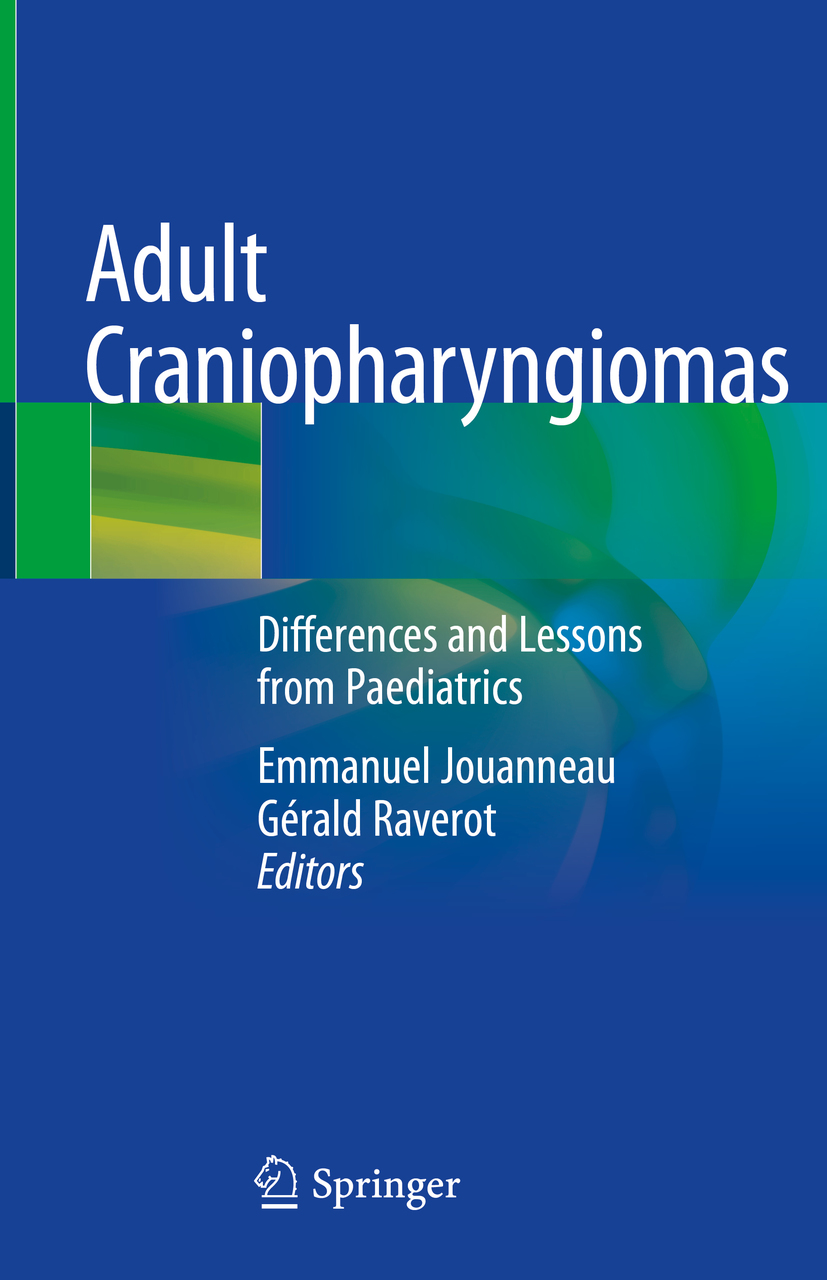Editors
Emmanuel Jouanneau and Grald Raverot
Adult Craniopharyngiomas
Differences and Lessons from Paediatrics
Editors
Emmanuel Jouanneau
Skull Base and Pituitary Neurosurgical Department, Hpital Pierre Wertheimer Groupement Hospitalier Est Hospices Civils de LyonClaude Bernard Lyon 1 University, Lyon, France
Grald Raverot
Endocrinology Department, Reference Center for Rare Pituitary Diseases HYPOGroupement Hospitalier Est Hospices Civils de LyonClaude Bernard Lyon 1 University, Lyon, France
ISBN 978-3-030-41175-6 e-ISBN 978-3-030-41176-3
https://doi.org/10.1007/978-3-030-41176-3
Springer Nature Switzerland AG 2020
This work is subject to copyright. All rights are reserved by the Publisher, whether the whole or part of the material is concerned, specifically the rights of translation, reprinting, reuse of illustrations, recitation, broadcasting, reproduction on microfilms or in any other physical way, and transmission or information storage and retrieval, electronic adaptation, computer software, or by similar or dissimilar methodology now known or hereafter developed.
The use of general descriptive names, registered names, trademarks, service marks, etc. in this publication does not imply, even in the absence of a specific statement, that such names are exempt from the relevant protective laws and regulations and therefore free for general use.
The publisher, the authors, and the editors are safe to assume that the advice and information in this book are believed to be true and accurate at the date of publication. Neither the publisher nor the authors or the editors give a warranty, expressed or implied, with respect to the material contained herein or for any errors or omissions that may have been made. The publisher remains neutral with regard to jurisdictional claims in published maps and institutional affiliations.
This Springer imprint is published by the registered company Springer Nature Switzerland AG
The registered company address is: Gewerbestrasse 11, 6330 Cham, Switzerland
Foreword 1
The clinical history of the craniopharyngioma begins with the extraordinary French Neurologist, Joseph Jules Francois Felix Babinski, who, in 1900, described a patient with dystrophic adiposity and sexual infantilism who was found to have a cystic lesion in the area of the pituitary. In his 1912 monograph,The Pituitary Body, Harvey Williams Cushing described lesions that arose from the embryonic cranio-pharyngeal duct; however, he had not at this time encountered any of these cysts and tumors surgically. Many different names had been given to the tumors that we currently identify as craniopharyngiomas (a term coined in 1931 by the Philadelphia Neurosurgeon, Charles H. Frazier). In his 1932 monograph on brain tumors treated surgically, Cushing described 92 craniopharyngiomas, recording poor outcomes with regard to morbidity and mortality. In fact, Cushing had called these tumors the most formidable of intracranial tumors and also wrote that Craniopharyngiomas are the most baffling problem which confronts the Neurosurgeon. Today, this remains relatively unchanged!
Although much has been written about the management of childhood craniopharyngiomas, these tumors are also problems in adults, and there are different considerations, nuances, and technical aspects in considering the management of adult craniopharyngiomas, which is the focus of this innovative and extraordinarily helpful volume. In fact, there are some studies that contend that in addition to presentations in childhood, the age-specific incidence of craniopharyngiomas increases as the population ages.
This well-conceived and contemporary book includes contributions from acknowledged experts in neurosurgery, endocrinology, pathology, epidemiology, pediatrics, medicine, neuroradiology, neuro- and radiation-oncology, and genetic and molecular biology. Their varying points of view emphasize the complexity of the subject and its potential and future solutions. They emphasize the necessity of a Team Approach and the collaboration of different specialties and scientists in addressing the challenges that this disease presents. Surely, their analysis of the pediatric experience offers us a platform from which to translate the lessons learned to the improvement of managing craniopharyngiomas in the adult population.
In a concise and targeted fashion, this book is the foundation of a pathway to the future and for further success in the management of our patients with this fascinating and multifaceted entity of the craniopharyngioma.
Edward R. Laws
Foreword 2
The ideal management of craniopharyngiomas is still unresolved and controversially discussed, despite a century of studies and remarkable evolutions of imaging, surgery, and radiation techniques. Harvey Cushing once called them the most forbidding of the intracranial tumors for their association with hypothalamic disturbances and for their tendency to recur. Still, to date, there are many obstacles in their management: For individual surgeons, it is difficult to gain experience with these lesions since they are rare disorders, with most of them treated in specialized centers. However, even these centers do not see more than a handful of such patients every year. Some of them report excellent treatment results and a high proportion of surgical resections.
Surgery of craniopharyngiomas is not only a matter of surgical skills and expertise. The threat of hypothalamic injury with its sequelae, such as uncontrollable gain of weight, is a much-feared effect of aggressive removal. Data from nationwide studies reveal that the mortality and morbidity associated with treatment can be worse than the effects that the tumor itself produces. On one side, there has been an enormous evolution in operative procedures: The extended transsphenoidal approach is one of the novel achievements, which allows extracting tumors that are not suitable for transsphenoidal surgery by conventional microscopic techniques a few years ago. The role of transcranial approaches is thus diminished. However, in some instances, the entire battery of craniotomies needed. Several different philosophies of surgeons remain as how to proceed with craniopharyngiomas: Some argued for most radical extraction in each and every patient and dwell on their microsurgical skills. Others advised just to relieve the mass effect by the most minimally invasive procedures available and recommend observation or adjuvant irradiation. Some apply a more differentiated approach in their patients tailored to the individual tumor and the patients specific situation, respectively, with a variable extent of resection. To date, such an individualized strategy is preferred and referred to as precision medicine. It is undoubtedly advantageous, if an individual tumor can be completely extracted without untoward side effects.
On the other side is the threat of treatment-induced hypothalamic damage. The concept of not damaging the hypothalamus with horrible sequelae and major impairment of quality of life is based on the availability of prognostic scales, which provide us with some estimation of the likelihood of hypothalamic damage derived from the imaging patterns of size, composition, and localization of the tumors upon their presentation. There are meanwhile several scales available, deriving from different centers. At least to some degree of probability, we can predict the patients at major risks. After all, we have radiotherapy as yet, and hopefully in the future medical treatments will become available for the different types of craniopharyngiomas. The molecular differential diagnosis between adamantinomatous and papillary craniopharyngioma is to date no more just based on microscopic morphological features but molecular characteristics, such as the wnt-pathway is disrupted or a BRAF V600 mutation can be detected. Consequently, there should be appropriate drugs which interfere with signal disruptions, and in a few case reports the positive effect of appropriate drug administrations has been documented.

